A GG Selfie
 |
Publisher's Corner
If you would like to read a version of
the Golden Gringo Chronicles
in a narrative format,
as a hard-copy novel
or an e-book
check it out HERE
JUST RELEASED! Mariposa, A Love Story of Costa Rica JUST RELEASED!
NOW AVAILABLE ON AMAZON.COM!
 Five hundred years before the Spanish found the American
continent, around the end of the first millennium, Native Americans lived and prospered in Central America, including the land now known as Costa Rica. Truly a natural wonderland then and now, the natives were able to employ their farming skills and prosper from the rich soils, the forests filled with game, herbs, and spices, and the lakes and two oceans rich with fish and crustaceans.
Five hundred years before the Spanish found the American
continent, around the end of the first millennium, Native Americans lived and prospered in Central America, including the land now known as Costa Rica. Truly a natural wonderland then and now, the natives were able to employ their farming skills and prosper from the rich soils, the forests filled with game, herbs, and spices, and the lakes and two oceans rich with fish and crustaceans.
Mariposa, or butterfly, is a story about two young Native Americans, each a favored child of a chief, but of different tribes. These two tribes, historically hostile to each other, lived a few days march apart in the mountains north and east of Costa Rica’s central valley.
The two natives meet by accident, fall in love and begin to plan a life together only to be frustrated by events beyond their control. The lovers are eventually drawn to a mountain volcano which is thought by many to be the home of the gods, particularly Sib'ö, the Great Spirit, who they believe had created the world.
The story as written incorporates the classic ending of Costa Rica's Legend of Zurqui, one that reflects the beauty, mystery and spirituality that is Costa Rica.
Preview the Book on Amazon.com at: Mariposa Preview
(This is Chapter 1 in its entirety)
ORDER IT HERE ($7.95): Mariposa on Amazon.com (Kindle Version Available - $4.99)
See All the Books by this Author Here: Books by Bob Normand
Spanish Version Coming Soon! (On Amazon, Probably in December)
Próximamente: "Mariposa, Una historia de amor de Costa Rica" en Español
Quinientos años antes de que los españoles encontraran el continente Americano, cerca del final del primer milenio, nativos americanos vivieron y prosperaron en Centroamérica, incluyendo la tierra ahora conocida como Costa Rica. Al ser en verdad una maravilla natural entonces y ahora, los nativos fueron capaces de emplear sus habilidades agrícolas y prosperar gracias a su fértil suelo, al bosque lleno de presas, hierbas y especias, a los lagos y a dos océanos ricos en peces y crustáceos.
Mariposa es una historia sobre dos jóvenes nativos americanos, los dos hijos privilegiados de un jefe, pero de diferentes tribus. Estas dos tribus, históricamente hostiles entre ellas, vivían a unos pocos días de marcha de distancia en las montañas del norte y del este del valle central de Costa Rica.
Los dos nativos se conocen por accidente, se enamoran y comienzan a planear su vida juntos, que se frustra únicamente por eventos más allá de su control. Los amantes son arrastrados a un volcán el cual muchos creen que es el hogar de los dioses, particularmente de Sib’ö, el Gran Espíritu, que creen que fue quien creó el mundo.
Como estas historias son leyendas, involucran una buena cantidad de mito, lo que deja tanto al escritor como al lector la libertad de especular diferentes desenlaces. La historia como está escrita incorpora el final clásico de la legenda de Zurquí, que refleja la belleza, misterio y espiritualidad de Costa Rica.
Broken News
(All the News That's Fit to Reprint)
Mega Numbers Are Up
Hubble Photo of Galaxy M-83
 |
Astronomers have long been intrigued with figuring out how many stars are out there. Given the numbers and distances involved we have to forgive our astro-amigos for not having a precise count.
For years scientists have estimated there is, oh let's say, 100 billion was a good estimate of the number of galaxies and each galaxy in turn had about 100 billion stars. Nice even numbers to work with yielding a total of 10,000,000,000,000,000,000,000 stars in the universe. I have no idea if there is a name for a number like that, like deca-mega-trillion or whatever, but that's a lot of suns. (It does pale in comparison to a "Google" of something, however, which is 1 followed by 100 zeros)
But scientists never stopped calculating and refining their estimates, and now an astrophysics professor at the University of Nottingham in England reports that he led a team that came up with the latest estimate which says that there are as many as two trillion galaxies in the universe. That multiplies the number above by 20 to 200,000,000,000,000,000,000,000. That's a lot of sunscreen.
Our own Milky Way galaxy is richer in suns than your average galaxy and is believed to contain around 300 billion stars. Our local solar system is also richer than the average in planets, having nine. Scientists say that most suns average closer to one planet per sun but, if our scientific friends underestimated the number of suns in the same way they did the number of galaxies, the expected number of planets would be about 1,800,000,000,000,000,000,000,000.
That makes the odds that we're all alone on this planet in this universe:
1 in 1,800,000,000,000,000,000,000,000.
Really? Fat chance.
And Micro Numbers Down
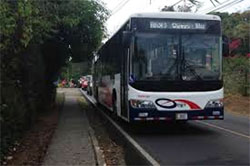 While the scientists were busy pumping up the numbers of suns and planets in the universe our local bus company was calculating numbers with equal precision but with a lot fewer zeros. They decided to reduce fares once again. The Quepos-Manuel Antonio route was slashed to 295 colones (54 cents US) from 305. That's a savings of ten colones or almost two cents US. This was on the heels of another slash in April of 5 colones (1 cent US) from 310 to 305.
While the scientists were busy pumping up the numbers of suns and planets in the universe our local bus company was calculating numbers with equal precision but with a lot fewer zeros. They decided to reduce fares once again. The Quepos-Manuel Antonio route was slashed to 295 colones (54 cents US) from 305. That's a savings of ten colones or almost two cents US. This was on the heels of another slash in April of 5 colones (1 cent US) from 310 to 305.
The local bus fare had peaked in June of 2014 at 320. When GG first came here the local bus fare was 160 colones. The rapid rise that occurred from 2009 to June of 2014 reflected the upward trend in petroleum costs.
Of course, with regard to the current fare decrease, the gilded dude wants to ask: Wouldn't it be easier for the drivers to make change if the fare had been leveled off at an even 300 colones? I doubt there would be much objection by the patronage. But as a friend once said to me: "Step back from the logic Bob, it doesn't apply here".
But every little decrease does help the working Tico. The change has no effect on dudes like GG who have a residency card and have attained the Golden Gringo age of 65+. Our fare on local busses is zero. It's a beautiful thing, amigos.
Air Costa Rica
Finally, an airplane with markings on the side that say "¡Pura Vida!" or at least "PURA VIDA".
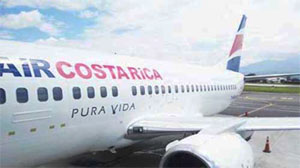 Air Costa Rica is a new subsidiary of Air Panama, the latter being the second largest airline in Panama after Copa Airlines. ACR, to be based in Juan Santamaria Airport in Alejuela, started operations in October with a initial charter flight to Guatemala City. Regular commercial flights will begin in the first quarter of 2017 and flights are planned to San Andres, Cartagena (Colombia both), Roatan (Honduras) and Punta Cana (Dominican Republic).
Air Costa Rica is a new subsidiary of Air Panama, the latter being the second largest airline in Panama after Copa Airlines. ACR, to be based in Juan Santamaria Airport in Alejuela, started operations in October with a initial charter flight to Guatemala City. Regular commercial flights will begin in the first quarter of 2017 and flights are planned to San Andres, Cartagena (Colombia both), Roatan (Honduras) and Punta Cana (Dominican Republic).
ACR also plans flights to the U.S. in the near future. The Air Costa Rica "fleet" currently consists of one Boing 737-300 but is expected to increase to four of these workhorses in short order.
"Is it a low-cost airline?" asked one reporter of Air Costa Rica management. The answer was as politically obsequious as a candidate running for president: "Ticket prices will not be low cost but they will be at the lower end of the market." said Carlos Viquez, the new General Manager of Air Costa Rica.
 Well maybe Air Costa Rica is not a low cost airline but a new competitor, Wingo, does bill itself as a low cost airline. Wingo is owned by Panama's Copa Group, ($142 bucks SJO to Panama City round trip) the parent of Copa Airlines. Starting December 1, it's also entering the market with flights beginning December 1 between San José and both Panama and Guatemala. So it seems that Panama is making significant inroads into the Costa Rican market with subsidiaries of their top two airlines (Copa and Air Panama) now offering two lower cost competitors (Air Costa Rica and Wingo).
Well maybe Air Costa Rica is not a low cost airline but a new competitor, Wingo, does bill itself as a low cost airline. Wingo is owned by Panama's Copa Group, ($142 bucks SJO to Panama City round trip) the parent of Copa Airlines. Starting December 1, it's also entering the market with flights beginning December 1 between San José and both Panama and Guatemala. So it seems that Panama is making significant inroads into the Costa Rican market with subsidiaries of their top two airlines (Copa and Air Panama) now offering two lower cost competitors (Air Costa Rica and Wingo).
I'm sure there is no reason to doubt that air travel will continue to increase and the need for additional flights will be required. Do you remember a dozen or so years ago when there were about a dozen airlines with commercial flights out of SJO? Back then, there were about a half dozen flights clustered between noon and 2 PM going to the States to choose from and maybe another half-dozen connecting airlines. Now there are over 30 commercial airlines including six major U.S. carriers with multiple daily flights, as well as over 10 cargo carriers. Passenger count in 2015 exceeded 4.3 million. SJO is growing up, amigos.
The growth in air travel here is what motivated the government recently to commission a study on placement and design of a major new international airport near Orotina, a town about 60 km (35 miles) west of San José but closer to the Pacific Coast. The new location is not a favorite idea amongst the San José locals because of the longer driving distance.
So, how long will it be before Air Costa Rica will be called Air Tico or TicoAir?
Meds by Drone
Maybe GG will soon be relieved from the task of going out to the Quepos Hospital to pick up his monthly allotment of medicines (medicamentos).
Meds by Drone
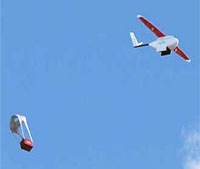 |
The Caja (cah-hah), the section of the social security ministry responsible for the national health system, recently announced they had signed a contract with an outfit called Zipline International, Inc. of California (now, is that a perfect name for this part of the world, or what?) to provide a service here to deliver medications by drone.
Zipline International, Inc. already has such operations in Rwanda and Tanzania. The service is particularly suited for those hard to get to rural areas like the central spine of mountains that run down the center of Costa Rica where reaching some of the indigenous people who live there can take 1-2 days by normal ground transportation.
They estimate delivery cost at $2 per prescription (actually, the cost is slightly over $26,000 per month regardless of the number of drops). But there are bureaucratic hurdles to overcome including a nearly $2,000 registration fee per drone and what rules are to be established regarding air space in which the drones are permitted to operate without interfering with things like airport operations. GG also wonders (there you go again asking questions) how the Caja, an organ of the government, is going to handle special meds like narcotics - can't be dropping those all over the countryside, can we?
GG has visions of standing on my balcony with a large fishing net waiting for my coumadin-laden parachute to descend so I can snare it. Nah, I doubt that they would consider Quepos rural enough to include it in the program (maybe in Phase II). Guess I'll still have to take the bus out to the hospital where the Caja pharmacy is located.
What's next, McDonald's and POPS by drone? I hope so!
New Tent City
The Chronicles has reported on the continuing migrant difficulties that central america and Costa Rica in particular have encountered recently. First were some 8,000 Cubans that entered from Panama in the south but were stopped at the northern border at Peñas Blancas as they were refused entry by Nicaragua. Later, they were ferried by air to the Mexico/U.S. border by the Costa Rican government so they could walk across, supposedly under the old "wet foot/dry foot" policy.
Migrant Camp at Saint cecilia
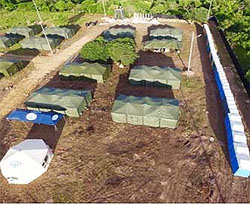 |
Next came a few thousand more "Cubans" with Haitian, Dominican Republic and African accents that showed up at our southern border, some with supposedly real Cuban passports. It's estimated that an additional 5,000 people like this gradually and surreptitiously made their way north on foot purportedly to do the same as the Cubans at the Mexico/U.S. border. That still leaves another five or six thousand people accumulated near the border who've been living in temporary camps. One such camp is at Santa Cecilia near La Cruz in Northwest Costa Rica and is shown in the photo to the right, The relationship of La Cruz to the border is shown in the feature article on our latest trip to Nicaragua reported below.
Santa Cecilia is a tent camp (photo right) and guess where the tents came from; they were a gift from the good old U.S. of A. It's unclear as to the original intent for the tents but they are now being used to house stranded migrants. Two tent cities are currently housing about two thousand visitors. Reportedly there are an additional 9,000 immigrants of various origins currently wandering about Colombia, Panama and Costa Rica.
As if that wasn't enough, Sarah Saldana, director of the U.S. Immigration and Customs Enforcement, told the House Committee on the Judiciary of the U.S. Congress a week ago that some 40,000 Haitians are making their way north in Central America with the United States as the goal.
This story won't go away soon.
Quepos Quickies
 New Quepos Bridge Still Abuilding. In May of this year the Chronicles bemoaned the disappearance of the last one lane bridge into Quepos. The Bailey Bridge between the Boca Vieja section and downtown Quepos served the community well over the years but, as the town grew, it became a hang up for traffic as one side of traffic had to give way to the other and in recent years those backups became considerable.
New Quepos Bridge Still Abuilding. In May of this year the Chronicles bemoaned the disappearance of the last one lane bridge into Quepos. The Bailey Bridge between the Boca Vieja section and downtown Quepos served the community well over the years but, as the town grew, it became a hang up for traffic as one side of traffic had to give way to the other and in recent years those backups became considerable.
So the old bridge was closed, then torn down or removed, actually I think Bailey Bridges just get picked up and loaded on barges for re-use, don't they? Construction began on a new two-lane bridge shortly thereafter. When I asked a construction foreman in May how long the project would take he responded with the official answer, "October" but with a devilish smile on his face.
GG just checked progress in early October and snapped the picture to the right. The main span in the center of the bridge seems virtually complete including the roadbed but very little has been done on the approaches. When I asked for a new completion estimate, a gent that appeared to have some authority over the others said "Diciembre, Senor".
A Christmas bridge then; but why did this guy also have a smirk on his face?
TOP
Rumble Talk
(Shaky Happenings On or the Pacific Rim)
On the local terremoto (tremor) front things were (fortunately) not too busy in October. Turrialba continued to boil and bubble and throw out ash occasionally, and Poaz was showing signs of life but nothing major occurred, although the main airport runways needed a brushing off once or twice again, yet no delays were reported.
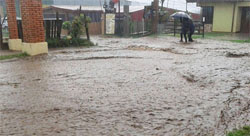 |
Flooded Street in Nicoya |
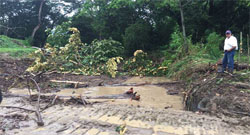 |
That's Suppose to be a
Bridge in the Lower Photo |
 |
Barceló Tambor in Normal Times |
The real action this past month was with the weather as many different parts of the country were inundated with heavy rain. October, historically, is the heaviest rainfall month of the year and this year was no exception (see historical chart). Some rivers overflowed and inundated some populated areas (see photo right).
There were several days of continuous rain resulting from a tropical wave combining with another low pressure system. GG always brags that these kind of days are rare here and mornings are most often sunny even in the rainy season - in the past that was true but not this month.
Heavy rains hit from coast to coast around mid-month, from the Nicoya Peninsula to the Caribbean. Some places, like the Nicoya, received 125 mm (5 inches) in a matter of a few hours. With so many hills in the country there were slides everywhere and several bridges washed out. Flooding was reported in Cartago where the terrain is pretty high up as well as in Golfito, the southern Pacific coast.
One hotel in Tambor on the Nicoya, the Barceló Tambor hotel had several inches of water in their main lobby. This is a beautiful hotel situated right on the beach on the southern tip of the Nicoya that GG and a friend had the pleasure of visiting for lunch on a pilgrimage to the Nicoya in 2015.
There was so much rain in October the national government issued a "green alert' to bring awareness of the potentionally dangerous situation to the populace.
Hopefully the worst is over.
TOP
Check Out Recent Earthquakes Around the World
Posted by the U.S. Geodetic Survey: Today's Quakes |
Search the Golden Gringo Chronicles Archives for Topics That Interest You
You can use our Archives to search for everything that has been written in over 200 feature articles of the Golden Gringo Chronicles plus find Broken News items and ROMEO restaurant reviews. Enter your topic or item to search in the Google Search Routine below and follow the links offered from the search results. Suggestion: Enter only a simple, precise and unique as possible keyword or two in order to narrow the number of references retrieved:
Golden Gringo Chronicles - Enter Search Here
Readers: Our publication is open to suggestions regarding future
articles and will accept pieces written by others but we reserve the right to decline
anything that the
editorial staff (that's GG) thinks is inappropriate for this format.
Send proposals, comments, suggestions, ideas, meaningless statements and
jocular observations concerning the Chronicles to GG here: gg@goldengringo.com.
Nicaragua Once More
(Renewing Acquaintances)
San Juan del Sur, Nicaragua
 |
About five years ago a small group of displaced male gringos (read expats) decided to hold a "round-up" in San Juan del Sur, Nicaragua. The intent at the time was to provide a weekend where guys could gather to relax enjoy good conversation and camaraderie. It was directed towards guys who loved to smoke good cigars of which there are plenty in Nicaragua (both cigars and cigar smokers). GG used to be a daily puffer but an incident of congestive heart failure ended my puffing career about seven years ago. (Yes, I'm jealous)
Sunset in San Juan del Sur
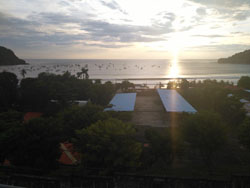 |
The gathering is a time to chew the fat and bring each other up to date, kind of a guys weekend out. The original gathering drew a baker's dozen of gentlemen with ages ranging from the early twenties to 70+ fossils like GG. This year marked the 5th annual event and drew some 47 puffers and non-puffers from all over Central America and even from the U.S. The meeting has since evolved into smoking and non-smoking sections in a building, usually a restaurant that we take over for our exclusive use and which is open to the air on at least two sides.
 |
| Nicaragua-Costa Rica Border Area |
GG and a few friends recently returned from Round-Up #5. The bus route we took passes through the area approaching the Peñas Blancas border crossing. The Google map to the right shows the relationship of San Juan del Sur ("A", top left), Peñas Blancas ("B") where the border crossing is and the Costa Rican town of La Cruz ("C" on the map, about 19 km or 11 miles south of Peñas Blancas). San Juan del Sur is about 45 km or 27 miles from Peñas Blancas by car. La Cruz is the town where the migrant tent camp mentioned in the news clip above is located.
Our group of four went by bus all the way to the border crossing at Peñas Blancas. Getting to San Juan del Sur by that method is not complicated but it is tedious and tiring. It involves taking three "collectivo" busses (ones that stop whenever someone wants to get off or on) and then a taxi from the border to SJDS.
We left on the first bus from Quepos at 6:30 in the morning and arrived in Puntarenas almost three hours later; actual elapsed time 2:50. We were able to pick up the next bus, going to Liberia, at the Puntarenas station within a half hour of arriving (elapsed time for the second leg: 2:55). We then quickly (like 5 minutes) picked up the next bus at the Liberia station that went to Peñas Blancas (elapsed time 1:30). Total time on busses - about 7-1/2 hours and a trip time of slightly over 8 hours since we had left Quepos.
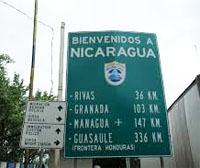 I had been somewhat concerned that the border would be a problem because of all the migrant activity that's been going on but it turned out to be quite easy and efficient on this early Friday afternoon in October. We paid our exit tax of $8 (this is the land version of the infamous Costa Rican air exit tax of $29) but had to pay it in cash as the ATM-like machine we would normally use was broken down. We then made the half-mile trek (well, maybe it was only a quarter mile) from the Costa Rica side to the Nicaragua side on foot where we paid a $1 local government tax and a $12 entry tax to the Nica federal government. The whole process took less than an hour.
I had been somewhat concerned that the border would be a problem because of all the migrant activity that's been going on but it turned out to be quite easy and efficient on this early Friday afternoon in October. We paid our exit tax of $8 (this is the land version of the infamous Costa Rican air exit tax of $29) but had to pay it in cash as the ATM-like machine we would normally use was broken down. We then made the half-mile trek (well, maybe it was only a quarter mile) from the Costa Rica side to the Nicaragua side on foot where we paid a $1 local government tax and a $12 entry tax to the Nica federal government. The whole process took less than an hour.
This is the Group of Reprobates, Derelicts & Escapees that Slipped Ashore at SJDS
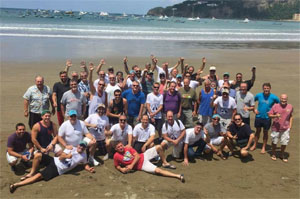 |
After passing the final passport check we negotiated a taxi big enough for the four of us. It was driven by a very friendly gent named Antonio who enjoyed bragging about his one and a half year old son. About forty minutes later we pulled into San Juan del Sur and three of us went to one hotel while the fourth went to a hotel less than a block away on the same street (SJDS is actually a bit smaller than Quepos). It turned out that the restaurant that the organizers of the round-up selected for our meetings was only two blocks away. Very convenient.
We had meetings Friday evening (buffet dinner), Saturday morning (breakfast), Saturday afternoon (barbecue) and Sunday morning (breakfast). Of course the meetings and meals were interspersed with visits to local parlors for the appropriate amount of ice creams and gelatos. We do our best to keep the affair civil, amigos.
Central Square Granada
 |
The formal gathering ended at noon on Sunday. Our group of four decided to take a taxi trip up to Granada for Sunday afternoon and we were aided by a local resident and member of the group in finding another helpful driver (Danny) who whisked us from SJDS to the old Spanish capital in just over an hour. We gave ourselves a walking tour and then ended up in an excellent restaurant (El Tercer Ojo - The Third Eye) where we gorged some more. Excellent. Our driver met us for dinner and then scooted us back to San Juan in time for us to collapse exhausted just after 9 PM.
San Juan del Sur and Granada continue to be pleasant places to visit and I, for one, hope to be able to make the 2017 gathering.
For more info on San Juan del Sur and Granada gleaned from previous trips, go here:
Navigating Nicaland and Cavorting in Nicaragua Once More, and for another view on walking through the Peñas Blancas border go here: The Peñas Blancas Border.
¡Solo Bueno!
TOP
Costa Rica in World War II - Part One
(Paradise on the Outskirts of Hell)
Costa Rica is known for it's lack of an army or navy. The military was disbanded, i.e., written out of the constitution when the Second Republic was founded in 1949 after the country's civil war ended in 1948, three years after World War II ended. Today's government is the latest in a continuous series of governments since then, some 67 years of peaceful transitions of power for which few Latin American countries can boast an equal record.
Costa Rica Declaration of War
December 8, 1941
 |
So when World War II broke out (1939) Costa Rica had some armed forces but they could hardly have been perceived as a major player in the war. Nevertheless, when Pearl Harbor was attacked, Costa Rica lost no time in declaring war on the Axis powers. They did so on December 8, 1941 one day after pearl harbor and technically ahead of the United States, whose own official declaration of war wasn't passed by congress until December 11. (Of course there is that famous film of Roosevelt asking congress to make the declaration retroactive to the moment of the attack).
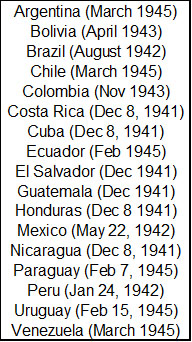 Of seventeen Latin American countries at the time, Costa Rica was one of only three that declared war the day after Pearl Harbor. The other two were Honduras and Nicaragua. Six of those seventeen countries (Argentina, Chile, Ecuador, Paraguay, Uruguay, and Venezuela), having absorbed a significant number of German emigres over the years and also because they favored military governments, had strong Nazi sympathies and didn't declare war on Germany until a month or two before the end of the war (see table to the right). VE day, Victory in Europe Day, was on May 8, 1945.
Of seventeen Latin American countries at the time, Costa Rica was one of only three that declared war the day after Pearl Harbor. The other two were Honduras and Nicaragua. Six of those seventeen countries (Argentina, Chile, Ecuador, Paraguay, Uruguay, and Venezuela), having absorbed a significant number of German emigres over the years and also because they favored military governments, had strong Nazi sympathies and didn't declare war on Germany until a month or two before the end of the war (see table to the right). VE day, Victory in Europe Day, was on May 8, 1945.
Costa Rica's quick action, of course, immediately made Ticoland a target for the Nazis. A friend forwarded an article to me about WW II and Costa Rica written by a Mr. Walter ("Picho") Hamer, a fellow writer who had a long time experience in Latin America and particularly Costa Rica. Here's Walter's self-written bio:
"I’m a “banana brat” of the United Fruit Co. I was born in Puerto Cortes, Honduras, and lived there, and Santa Marta, Colombia, and, finally, in San José. I came to Costa Rica in ’42 and left in ’46. My father was the General Manager of the Compañía Bananera de Costa Rica, the UFCo subsidiary which owned its banana operations on both coasts of the country. I was enrolled in the Escuela Buenaventura Corrales (La Metálica) and spent my days learning and playing in Spanish. My fondest childhood memories are contained in my four-year San José sojourn, and I have a special place in my heart for Costa Rica and the Ticos. Sadly, my Dad was killed in November of 1946 in an airplane accident while returning to San José from Golfito, and we moved to New Orleans and a new life. I’m now 84 years old and retired and have taken up recreational writing as a hobby…hence the San Pablo bit."
The following article by "Picho" is about a provocative war incident that occurred in Costa Rica on the Caribbean coast, a happening that understandably shocked the little country and caused a strong reaction towards Germans living in this country in the early 1940's. The article will be in two parts with the concluding part in next month's Chronicle. (Pictures and captions were added by GG for editorial support)
WAR COMES TO A QUIET PLACE
The Main Concern in 1941 Was the National Futbol Team and the Caribbean Championship
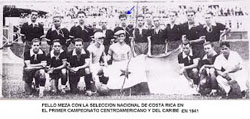 |
"The spring of 1942 marked the third year of the Second World War, that gigantic conflict that involved almost every country of the world. While the people in the peaceful little Central American nation of Costa Rica were acutely aware of the great struggles going on in Europe and eastern Asia, they were not affected by them in any direct way. For the most part they carried on their lives very much as they had before the conflict, confident that the wide expanses of the Atlantic and Pacific Oceans would keep them from any danger of direct aggressive harm. The proximity of the United States and its defenses of the nearby Panama Canal provided an added measure of comfort.
From the outbreak of hostilities, Costa Rica had been quick to place itself in the Allied camp, and had immediately declared war on both Germany and Japan when the United States formally entered the conflict in 1941. Aside from small amounts of raw rubber and hemp for marine cordage, the country’s main contribution to the war effort was the steady supply of food products not available in the temperate climates of its larger allies. Coffee, bananas, and cacao were transported to the port city of Limón, from whence they were shipped through the Caribbean and the Gulf of Mexico to southern ports of the United States.
The country’s complacency was rudely broken in the early summer of that year, however, when, in an act of extreme audacity and uncommon bravery, a German submarine captain brought the harsh reality of war directly to Costa Rica’s shores. Submarine activity in the South Atlantic and the eastern Caribbean was a recent feature of the war. The strategy of the German Navy, the Kriegsmarine, at the outset of the conflict was to use its extensive fleet of U-boats to interdict the flow of vital supplies being shipped across the North Atlantic from the United States and Canada to Great Britain.
14.1 Million Tons and 2,779 Ships Were Sunk by U-boats in WWII
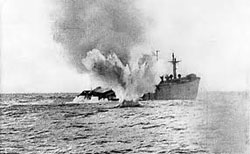 |
This plan was highly successful initially, as there were few defenses to keep the U-boats from preying freely on the slow-moving freighters, and large numbers of them and their valuable cargos were sent to the bottom. However, as the war progressed, anti-submarine warfare technology and methods were developed by the Allies which soon made the Atlantic convoys more difficult to approach and attack. U-boat losses increased quickly, causing the Kriegsmarine to refocus a large segment of its submarine activity to a newly designated “Brazil Sector”, which covered the western reaches of the South Atlantic Ocean and the eastern end of the Caribbean.
The strategic purpose of this move was to interrupt the flow of petroleum products coming from the large Dutch and American refineries at Aruba, Curacao, and Trinidad. These plants were processing crude oil from Venezuela and shipping the refined fuels to Britain and the United States. There were also shipments of other vital supplies, such as bauxite, the ore for making aluminum, which were transported through the Brazil Sector from South American mines to the factories of the United States. The Kriegsmarine designed and built new, long-range submarines and sent them out from bases in Nazi occupied France. These patrols lasted from three to four months or, as was more commonly the case, until the U-boat ran out of torpedoes.
A few sinkings took place close to the harbors of the big refineries, but, for the most part, these warlike activities took place on the high seas, well away from the mainland of the Central and South American countries, and so did little to frighten their citizens. The hunting around the refineries was soon discouraged by the increase of anti-submarine resources in those locations, causing the U—boats to range further into the Caribbean and even as far as the Gulf of Mexico. They also widened their choice of targets to include any non-neutral shipping they could find.
Captain A. Achilles
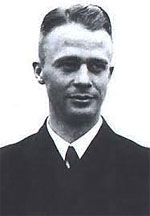 |
Early in the morning of the 28th of April, 1942, the U-161, a class IXC long-range submarine under the command of Kapitanleutenant Albrecht Achilles, set sail from the port of Lorient in Nazi occupied France. This was the twenty eight year old commander’s third wartime patrol to the Brazil Sector. These waters were familiar to him, having served before the war as an officer on the passenger liners of the Hamburg-Amerika steamship service on its runs to South America and the Caribbean.
He rendezvoused with a Milch Cow refueling ship in mid-Atlantic and topped up his diesel tanks before proceeding on to the northeastern coast of South America. He patrolled the waters around the big oil refineries at Trinidad, Aruba and Curacao in hopes of finding a tanker, but surface traffic was light. The Allies had intensified their anti-submarine defenses and their airborne patrols since the submarines had become active in the area, and Captain Achilles felt that the risk of discovery and destruction was greater than the possibility of finding a worthwhile target. He moved on to the waters north of Colon, Panama, where the Panama Canal funneled traffic into the open Caribbean. He had more success there, and was able to sink two small freighters.
Aerial Attack Photo of U-161
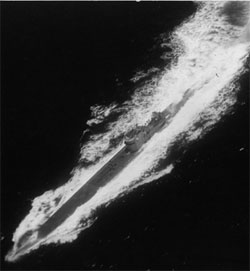 |
This stirred up the hornet’s nest of anti-submarine patrol aircraft located at the American bases in the Canal Zone, forcing him to move further away from the Canal entrance. Late in the evening of July 1st, as U-16l was patrolling the western edge of its new hunting area, the lookouts reported a ship to the south, steaming toward the nearby Costa Rican port of Limón. Captain Achilles set out in pursuit of the vessel, but was too far away to get into an attack position before it entered the harbor. He had gotten close enough to identify the ship as the San Pablo, a 3,300 ton steam merchant in the service of the United Fruit Company for carrying general cargo and bananas. The ship’s registry was Panamanian, which made it a legitimate target for the prowling U-boat.
Convinced that he had not been seen, Captain Achilles approached the port on the surface under cover of the dark tropical night, studying the harbor’s accesses and looking for any sort of defenses. Although the lighthouse and the illuminated channel markers were not operating, the city itself did not appear to be observing any blackout precautions, so the harbor and waterfront were brightly lighted. The port appeared to be unarmed and his electronic listeners did not detect any of the feared long-range patrol aircraft from the American bases in Panama. The only protection appeared to be a floating boom placed across the harbor’s entry channel with one end secured to a fixed platform and the other tied to a mooring buoy.
A heavy submarine net made of steel cable hung down from the length of the boom like a great curtain, effectively blocking underwater access to the harbor. This protective gateway was operated by a small utility launch which, when required, would release the free end of the boom from its mooring, and tow it to one side to allow the passage of surface traffic. The gate was long and cumbersome, weighed down as it was by the heavy steel net, and the launch was small and underpowered for the task, so the cycle of opening and closing the channel was very slow.
During the following day, July 2nd, U-161 lingered several miles off the port, making several submerged approaches to the coast to further study the harbor and to monitor traffic. Late that evening it saw a small coastal trader heading in to Limón. Under cover of darkness, Captain Achilles brought the submerged U-boat into a trailing position close astern of the trader. As the small vessel approached the port, the defensive gate was hauled open and U-161 took full advantage of the slow operation of the boom to enter the harbor through the opened net close behind the coaster."
--- *** ---
Part 1 above of Picho's article does a great job at setting the stage for the rest of the story. Don't miss next month's final part that describes the actual incident and the fall out from it.
Thanks much to Picho for his contribution.
¡Pura Vida!
TOP
Passionflowers
(More Relaxation than Passion)
 Much has been said in many places, including the Chronicles, about the incredible biodiversity of Costa Rica. We are out of balance compared with the average country out there, based on land area, by a factor of 600:1. That is we have 6% of all the biodiversity in the world including 13,630 "amphibian, bird, mammal, reptile, and vascular plant species", the 15th largest total of all countries. And this in a land that takes up only .01% of the world's land surface (19,700 square miles in a total of 197 million).
Much has been said in many places, including the Chronicles, about the incredible biodiversity of Costa Rica. We are out of balance compared with the average country out there, based on land area, by a factor of 600:1. That is we have 6% of all the biodiversity in the world including 13,630 "amphibian, bird, mammal, reptile, and vascular plant species", the 15th largest total of all countries. And this in a land that takes up only .01% of the world's land surface (19,700 square miles in a total of 197 million).
For the last eighteen years GG has had the pleasure of living in places where flowers grow all year long (Florida - 10 years, then Costa Rica 8 years). Although I could never be accused of being a floriculturist (betcha didn't think I knew that word, did ya), I have always enjoyed being around plants and particularly flowering plants. In Costa Rica we have some of the most beautiful plants and flowers that exist on the planet; and it's hard not to be surrounded by them even if you don't want to be.
Passionflowers
 |
 |
As an example of incredible beauty, take the passionflower. The delicacy and beauty of this specie is stunning. Actually there are 53 sub-species of this flower in Costa Rica alone, and they represent over 10% of all the passionflower species in the world. We don't have the room here in the Chronicles nor the will power to show all the species but just take a gander at some of those beauties starting with the two at the left.
 |
Maracuyá on the Vine |
 |
Maracuyá Opened |
The flower in the passionflower eventually produces a fruit, several varieties actually, that has its own amazing characteristics. The fruit is called maracuyá (ma-ra-koo-yah) or granadilla (gra-nah-dee-ja) and one version is shown in the photos to the right. The lower photo is of a piece of the same fruit that has been opened.
GG first tried maracuyá at a Tico friend's house shortly after I arrived here in 2008. My friend emerged from his kitchen one day with a half dozen yellow, bulbous maracuyás in his arms like those shown in the photo. He took a paring knife and scored the bulb around the center. He then simply gave it a twist and the two halves cracked open revealing the gooey stuff shown in the picture. Then he offered me a whole on
e.
I was surprised at how light the fruit was, the shell being strong but almost like styrofoam in its weight. I let him pare the fruit for me but balked at eating the contents when I saw what I thought looked like three sacs of fish eggs inside. He simply slurped and gulped down the entire contents of his fruit and invited me to do the same. Oh what the hell, says GG and I quickly tossed the egg sacs down. I was immediately hit with a wonderfully sweet taste. Yummers.
Of course, both the fruit and the plant have extensive nutritional value. The following comments on the fruit's benefits relate to a 100 g (3-1/2 oz) serving of maracuyá (the numbers in parentheses are the percentages of RDA or recommended daily allowance):
-
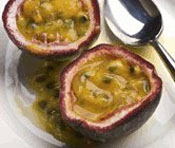 100 g of fruit contains about 97 calories (typical of an average apple).
100 g of fruit contains about 97 calories (typical of an average apple).
- Good source of dietary fiber at 10.4 g (27%) which helps remove cholesterol from the body.
- High in Vitamin C (50%), helps the body develop resistance against flu-like infectious agents and scavenge harmful, pro-inflammatory free radicals.
- Vitamin-A (43%). Vitamin A helps maintain healthy mucus membranes and skin. Consumption of natural fruits rich in vitamin-A, and flavonoids may help to protect from lung and oral cavity cancers.
- Rich in potassium (7%). Helps regulate heart rate and blood pressure.
- Also a very good source of minerals such as iron, copper, magnesium and phosphorus.
 The above ground parts of passionflower flowers, such as the stems, leaves and the vine, are crushed and used medicinally, taken as a tea or applied as a topical treatment or poultice. Passionflower is used as a natural remedy to treat a variety of ailments. These include anxiety, asthma, fibromyalgia, gastrointestinal upset and narcotics withdrawal. It can also be used as a pain reliever and anti-inflammatory aid.
The above ground parts of passionflower flowers, such as the stems, leaves and the vine, are crushed and used medicinally, taken as a tea or applied as a topical treatment or poultice. Passionflower is used as a natural remedy to treat a variety of ailments. These include anxiety, asthma, fibromyalgia, gastrointestinal upset and narcotics withdrawal. It can also be used as a pain reliever and anti-inflammatory aid.
Note: "While it is safe for consumption in small amounts, passionflower can cause side effects when taken in large doses, and it is known to have moderate negative interactions with central nervous system depressants, known as sedatives and tranquilizers."
Perhaps you were as uninformed as GG regarding the name of this flower (see the real etymology of the name in the What's-in-a-Word section below). Until I moved here I thought the "passion" in passionflower meant it was used as an aphrodisiac. Not so, oh tarnished one, the natural medicine in passionflower is actually used in nearly the opposite manner. It is often prescribed for sleep problems (insomnia), gastrointestinal (GI) upset related to anxiety or nervousness, generalized anxiety disorder (GAD), and relieving symptoms related to narcotic drug withdrawal.
 Passionflower is also used for seizures, hysteria, asthma, symptoms of menopause, attention deficit-hyperactivity disorder (ADHD), nervousness and excitability, palpitations, irregular heartbeat, high blood pressure, fibromyalgia, and pain relief.
Some people apply passionflower to the skin for hemorrhoids, burns, and pain relief as well as swelling (inflammation).
Passionflower is also used for seizures, hysteria, asthma, symptoms of menopause, attention deficit-hyperactivity disorder (ADHD), nervousness and excitability, palpitations, irregular heartbeat, high blood pressure, fibromyalgia, and pain relief.
Some people apply passionflower to the skin for hemorrhoids, burns, and pain relief as well as swelling (inflammation).
So once more the natural bounty of Costa Rica not only offers us something that is incredibly beautiful but also is good for our health.
¡Solo Bueno!
TOP
Health Stuff
Note: The information given in this section is offered as news information only and does not indicate GGC confirmation or denial of the accuracy of the treatment or a recommendation to pursue it, nor can we or do we guarantee the efficacy of the results nor validity of the conclusions proffered.
(How's that for a disclaimer?) |
Aguacate Awareness
Some things that are given a relatively exotic stature in the north are often commonplace here in the tropics. Take avocados for example (the Spanish is aguacate - agua-cah-tay) . They are a significant crop in the U.S. but somewhat restricted to farm production in the warmer areas like southern California and southern Florida.
 In Costa Rica, avocados are as common as apples (actually, probably more common) and, it seems, they're grown in everybody's back yard. Native to Costa Rica as well as Mexico and other Central America countries, avocados come in at least 19 varieties here.
In Costa Rica, avocados are as common as apples (actually, probably more common) and, it seems, they're grown in everybody's back yard. Native to Costa Rica as well as Mexico and other Central America countries, avocados come in at least 19 varieties here.
The good news is that almost all of these tropical delights are also healthy for you. Avocado has been smeared in the past by a myth that says it will get you fat when in fact the fruit is heavy in the same unsaturated fat found in olive oil. Some of the nutrients in avocados (oleic acid for one) inhibit several forms of cancer including oral, breast and prostate cancers. The fruit contains significant amounts of vitamin K, dietary fiber, potassium, folic acid, vitamin B6, vitamin C and copper.
 The first time I prepared an avocado I made a mess of it. How do you get around that huge nut? Then I learned the tricks: 1) make sure the avocado is ripe, i.e., slightly soft to the touch; raw or semi-raw ones are much more difficult to handle, 2) cut the fruit vertically around the lenghtwise meridian with a chef's knife or similar knife, 3) twist both halves to separate them (photo above), 4) I hold the piece with the nut in my left hand and slap the nut with the chef's knife (kind of machete style), lodging it in the nut which pops right out (others say remove the nut with a spoon), 5) gently squeezing the skin side of a half usually causes a half to pop out in one piece, otherwise use a spoon. Slice, chop or mash the fruit and use in salads and in cooking. I made a mean baked fish, avocado and tomato dish one day - how's that for healthy?
The first time I prepared an avocado I made a mess of it. How do you get around that huge nut? Then I learned the tricks: 1) make sure the avocado is ripe, i.e., slightly soft to the touch; raw or semi-raw ones are much more difficult to handle, 2) cut the fruit vertically around the lenghtwise meridian with a chef's knife or similar knife, 3) twist both halves to separate them (photo above), 4) I hold the piece with the nut in my left hand and slap the nut with the chef's knife (kind of machete style), lodging it in the nut which pops right out (others say remove the nut with a spoon), 5) gently squeezing the skin side of a half usually causes a half to pop out in one piece, otherwise use a spoon. Slice, chop or mash the fruit and use in salads and in cooking. I made a mean baked fish, avocado and tomato dish one day - how's that for healthy?
Nutritionists say adding two to three slices of avocado a day to your diet can have significant healthful benefits. A 100gm (3.5 oz) serving 3-4 times per week yields the same result.
Maybe the saying should be: "An avocado a day keeps the doctor away".
TOP
Travel Quote of the Month
Posted in a Rome, Italy laundry:
"Ladies, leave your clothes here and spend the afternoon having a good time."
(ah, those Italians...) |
What's-in-a-Word
Passionflower

The "passion" in "passionflower" refers to the passion of Jesus in Christian theology. In the 15th and 16th centuries, Spanish Christian missionaries adopted the unique physical structures of this plant, particularly the various parts of the flower, as symbols of the last days of Jesus and especially his crucifixion:
The white and blue passionflower in the photo to the left (P. caerulea) shows most of the elements of the Christian symbolism:
- The pointed tips of the leaves were taken to represent the Holy Lance.
- The tendrils represent the whips used in the flagellation of Christ.
- The ten petals and sepals represent the ten faithful apostles (excluding St. Peter the denier and Judas Iscariot the betrayer).
- The flower's radial filaments, which can number more than a hundred and vary from flower to flower, represent the crown of thorns.
- The chalice-shaped ovary with its receptacle represents a hammer or the Holy Grail
- The 3 stigmas represent the 3 nails and the 5 anthers below them the 5 wounds (four by the nails and one by the lance).
- The blue and white colors of many species' flowers represent Heaven and Purity.
TOP
ROMEO Corner
(Retired Old Men Eating Out)
Falafel Bar, Manuel Antonio
Location: Top of Manuel Antonio hill across the main MA road from Cafe Milagro and across the road that goes to Parador from the Promerica Bank (aka, Plaza Vista Manuel Antonio)
Hours: 10:30 AM to 9 PM Monday through Sunday
Parking: Street parking only.
Contact: Tel.: 2777-4135; Email: N/A; Website: N/A
Reviewing ROMEOS: Alma L., Bob N., Jerry C., Jon R., Kevin F., Lucius H., Lance M., Mary M.
To Review Our Rating System and Procedure, go here: R.O.M.E.O. Rating

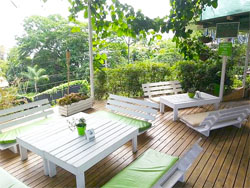 This restaurant is a little over two years old. The decor is early campground (see photo right). I'm not intending to be snarky here; just trying to convey that the place is extremely casual with most of the seating made up of wooden benches surrounding low wooden tables. There is one food service bar that seats about five people that overlooks the jungle leading down to the Pacific. Pleasant view in the day time.
This restaurant is a little over two years old. The decor is early campground (see photo right). I'm not intending to be snarky here; just trying to convey that the place is extremely casual with most of the seating made up of wooden benches surrounding low wooden tables. There is one food service bar that seats about five people that overlooks the jungle leading down to the Pacific. Pleasant view in the day time.
There was some difficulty in putting a table of eight together for us and we ended up with a mixture of seating from wooden benches to aluminum lawn chairs (check out the photo below showing the ROMEOS). Several of us came to the conclusion after some time that the place would come across better during lunch time. The ROMEOS gave the Falafel Bar a composite score of 3.2 sloths out of five possible for ambiance.
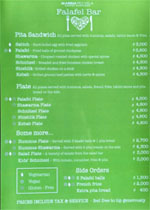 The menu was not extensive, consisting of a one page laminated placard (left) with a dozen or so middle eastern offerings. The menu was not extensive, consisting of a one page laminated placard (left) with a dozen or so middle eastern offerings.
GG had the Shawarma that had seasoned chicken in a light sauce, several shredded vegetables including beets and a glom of humus or something humus like. The food was fresh, gently cooked, tasty and well accompanied by the salads.
All eight ROMEOS favorably commented on the quality and freshness of the food. We gave the Falafel Bar a composite rating of 4.1 out of 5.0 for food quality.
|
 |
 .6 .6 |
$$.9 |
Value Index = 125 |
Fallafel ROMEO Group
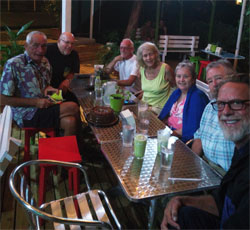 |
We were served by a young Israeli fellow who was friendly and helpful, but they have their own idea of a service system. That involves each person going into the inner room where the cashier is to order but we overrode that idea and got the young man to take our order at the table. They also found the idea of separate check difficult (quite a few restaurants here do also) but they worked it out at the end of the meal. Composite score for service was 3.5. That resulted in a combined score for atmosphere, food and service of 3.6 sloths.
The best surprise was the bill. For my plate of Shawarma and a very tasty lemon-lime fruit drink the total came in just over 6,000 colones (a little less than $11). Our group gave a cost rating of 2.9, one of the best (lowest) dollar ratings of any place we've been to in this area in recent memory. That yielded a Value Index of 3.6/2.9x100=125, putting Falafel Bar in the top one third of our reviews for value.
So, for a good and tasty (middle eastern) meal at a very reasonable price, Falafel is a good bet (but you may want to bring a cushion for some of the seating).
Written Comments on Falafel from ROMEOS
"A handrail at the entrance steps would be a big improvement for us older dudes."
"Food excellent, staff was helpful, but not fancy (I presume they meant the restaurant and not the staff - ed.). More of a lunch spot."
"Very healthy food, great staff, perfect lunch spot."
"I was very happy with everything."
|
Golden Gringo Chronicles Novel and E-Books Now Available!
 The story of the Golden Gringo Chronicles is also available as a hard copy novel of 192 pages available through Amazon and all major online retailers. ($9.95)
The story of the Golden Gringo Chronicles is also available as a hard copy novel of 192 pages available through Amazon and all major online retailers. ($9.95)
Amazon link: GGC, the Book. (Kindle Edition available)
Follow GG through the first six years of his odyssey in making the decision to retire in Costa Rica, overcoming the trials and tribulations of moving and obtaining residency there and the fun and experience of actually living in Ticoland.
Ride along with the Golden Gringo as he learns about the rich, varied culture of Costa Rica, the incredible bio diversity, the charming nature of the Costa Rican people and the ease with which a sometimes clueless ex-pat can assimilate into a small southwestern town on the Pacific coast.
Whether you are already a Costa Rican resident, someone contemplating a move here or just a traveler who enjoys different cultures, you will find the Golden Gringo Chronicles interesting, entertaining and informative about Costa Rica.
A narrative version of the Golden Gringo Chronicles is now also available as a trilogy of E-books in formats compatible with virtually all electronic platforms.
Part 1: (FREE!)
Leaving the Homeland
Part 2: ($3.99)
The Early Years
Part 3: ($3.99)
Becoming Tico, Maybe
Click on Part Number above for E-book sample downloads or click the price above right for purchase. (The best price is on Part 1; it's FREE)
Opt-In Here to Receive Your Free Copy Monthly
The Golden Gringo Chronicles is a free newsletter that is non-political, non-commercial and, hopefully, entertaining. By signing up you will receive an email each month around the first of the month giving you the links to the latest edition as well as to each individual feature and departmental section.
CLICK HERE TO SIGN-UP FOR THE
GOLDEN GRINGO CHRONICLES
or Email me at gg@goldengringo.com
Website: www.goldengringo.com

The Golden Gringo
Pura Vida!
To Contact GGC World Headquarters (yuk, yuk) to make comments, suggest topics or criticize my bad jokes, just send an email to: gg@goldengringo.com.
Be pithy but kind; I'm sensitive.
Unsubscribe from Golden Gringo Chronicles


 Five hundred years before the Spanish found the American
continent, around the end of the first millennium, Native Americans lived and prospered in Central America, including the land now known as Costa Rica. Truly a natural wonderland then and now, the natives were able to employ their farming skills and prosper from the rich soils, the forests filled with game, herbs, and spices, and the lakes and two oceans rich with fish and crustaceans.
Five hundred years before the Spanish found the American
continent, around the end of the first millennium, Native Americans lived and prospered in Central America, including the land now known as Costa Rica. Truly a natural wonderland then and now, the natives were able to employ their farming skills and prosper from the rich soils, the forests filled with game, herbs, and spices, and the lakes and two oceans rich with fish and crustaceans.
 While the scientists were busy pumping up the numbers of suns and planets in the universe our local bus company was calculating numbers with equal precision but with a lot fewer zeros. They decided to reduce fares once again. The Quepos-Manuel Antonio route was slashed to 295 colones (54 cents US) from 305. That's a savings of ten colones or almost two cents US. This was on the heels of another slash in April of 5 colones (1 cent US) from 310 to 305.
While the scientists were busy pumping up the numbers of suns and planets in the universe our local bus company was calculating numbers with equal precision but with a lot fewer zeros. They decided to reduce fares once again. The Quepos-Manuel Antonio route was slashed to 295 colones (54 cents US) from 305. That's a savings of ten colones or almost two cents US. This was on the heels of another slash in April of 5 colones (1 cent US) from 310 to 305.  Air Costa Rica is a new subsidiary of Air Panama, the latter being the second largest airline in Panama after Copa Airlines. ACR, to be based in Juan Santamaria Airport in Alejuela, started operations in October with a initial charter flight to Guatemala City. Regular commercial flights will begin in the first quarter of 2017 and flights are planned to
Air Costa Rica is a new subsidiary of Air Panama, the latter being the second largest airline in Panama after Copa Airlines. ACR, to be based in Juan Santamaria Airport in Alejuela, started operations in October with a initial charter flight to Guatemala City. Regular commercial flights will begin in the first quarter of 2017 and flights are planned to  Well maybe Air Costa Rica is not a low cost airline but a new competitor, Wingo, does bill itself as a low cost airline. Wingo is owned by Panama's Copa Group, ($142 bucks SJO to Panama City round trip) the parent of Copa Airlines. Starting December 1, it's also entering the market with flights beginning December 1 between San José and both Panama and Guatemala. So it seems that Panama is making significant inroads into the Costa Rican market with subsidiaries of their top two airlines (Copa and Air Panama) now offering two lower cost competitors (Air Costa Rica and Wingo).
Well maybe Air Costa Rica is not a low cost airline but a new competitor, Wingo, does bill itself as a low cost airline. Wingo is owned by Panama's Copa Group, ($142 bucks SJO to Panama City round trip) the parent of Copa Airlines. Starting December 1, it's also entering the market with flights beginning December 1 between San José and both Panama and Guatemala. So it seems that Panama is making significant inroads into the Costa Rican market with subsidiaries of their top two airlines (Copa and Air Panama) now offering two lower cost competitors (Air Costa Rica and Wingo).

 New Quepos Bridge Still Abuilding.
New Quepos Bridge Still Abuilding. 





 I had been somewhat concerned that the border would be a problem because of all the
I had been somewhat concerned that the border would be a problem because of all the 


 Of seventeen Latin American countries at the time, Costa Rica was one of only three that declared war the day after Pearl Harbor. The other two were Honduras and Nicaragua. Six of those seventeen countries (Argentina, Chile, Ecuador, Paraguay, Uruguay, and Venezuela), having absorbed a significant number of German emigres over the years and also because they favored military governments, had strong Nazi sympathies and didn't declare war on Germany until a month or two before the end of the war (see table to the right). VE day, Victory in Europe Day, was on May 8, 1945.
Of seventeen Latin American countries at the time, Costa Rica was one of only three that declared war the day after Pearl Harbor. The other two were Honduras and Nicaragua. Six of those seventeen countries (Argentina, Chile, Ecuador, Paraguay, Uruguay, and Venezuela), having absorbed a significant number of German emigres over the years and also because they favored military governments, had strong Nazi sympathies and didn't declare war on Germany until a month or two before the end of the war (see table to the right). VE day, Victory in Europe Day, was on May 8, 1945. 



 Much has been said in many places, including the Chronicles, about the incredible
Much has been said in many places, including the Chronicles, about the incredible 



 100 g of fruit contains about 97 calories (typical of an average apple).
100 g of fruit contains about 97 calories (typical of an average apple). The above ground parts of passionflower flowers, such as the stems, leaves and the vine, are crushed and used medicinally, taken as a tea or applied as a topical treatment or poultice. Passionflower is used as a natural remedy to treat a variety of ailments. These include anxiety, asthma, fibromyalgia, gastrointestinal upset and narcotics withdrawal. It can also be used as a pain reliever and anti-inflammatory aid.
The above ground parts of passionflower flowers, such as the stems, leaves and the vine, are crushed and used medicinally, taken as a tea or applied as a topical treatment or poultice. Passionflower is used as a natural remedy to treat a variety of ailments. These include anxiety, asthma, fibromyalgia, gastrointestinal upset and narcotics withdrawal. It can also be used as a pain reliever and anti-inflammatory aid. Passionflower is also used for seizures, hysteria, asthma, symptoms of menopause, attention deficit-hyperactivity disorder (ADHD), nervousness and excitability, palpitations, irregular heartbeat, high blood pressure, fibromyalgia, and pain relief.
Some people apply passionflower to the skin for hemorrhoids, burns, and pain relief as well as swelling (inflammation).
Passionflower is also used for seizures, hysteria, asthma, symptoms of menopause, attention deficit-hyperactivity disorder (ADHD), nervousness and excitability, palpitations, irregular heartbeat, high blood pressure, fibromyalgia, and pain relief.
Some people apply passionflower to the skin for hemorrhoids, burns, and pain relief as well as swelling (inflammation). In Costa Rica, avocados are as common as apples (actually, probably more common) and, it seems, they're grown in everybody's back yard. Native to Costa Rica as well as Mexico and other Central America countries, avocados come in at least 19 varieties here.
In Costa Rica, avocados are as common as apples (actually, probably more common) and, it seems, they're grown in everybody's back yard. Native to Costa Rica as well as Mexico and other Central America countries, avocados come in at least 19 varieties here. The first time I prepared an avocado I made a mess of it. How do you get around that huge nut? Then I learned the tricks: 1) make sure the avocado is ripe, i.e., slightly soft to the touch; raw or semi-raw ones are much more difficult to handle, 2) cut the fruit vertically around the lenghtwise meridian with a chef's knife or similar knife, 3) twist both halves to separate them (photo above), 4) I hold the piece with the nut in my left hand and slap the nut with the chef's knife (kind of machete style), lodging it in the nut which pops right out (others say remove the nut with a spoon), 5) gently squeezing the skin side of a half usually causes a half to pop out in one piece, otherwise use a spoon. Slice, chop or mash the fruit and use in salads and in cooking. I made a mean baked fish, avocado and tomato dish one day - how's that for healthy?
The first time I prepared an avocado I made a mess of it. How do you get around that huge nut? Then I learned the tricks: 1) make sure the avocado is ripe, i.e., slightly soft to the touch; raw or semi-raw ones are much more difficult to handle, 2) cut the fruit vertically around the lenghtwise meridian with a chef's knife or similar knife, 3) twist both halves to separate them (photo above), 4) I hold the piece with the nut in my left hand and slap the nut with the chef's knife (kind of machete style), lodging it in the nut which pops right out (others say remove the nut with a spoon), 5) gently squeezing the skin side of a half usually causes a half to pop out in one piece, otherwise use a spoon. Slice, chop or mash the fruit and use in salads and in cooking. I made a mean baked fish, avocado and tomato dish one day - how's that for healthy?

 This restaurant is a little over two years old. The decor is early campground (see photo right). I'm not intending to be snarky here; just trying to convey that the place is extremely casual with most of the seating made up of wooden benches surrounding low wooden tables. There is one food service bar that seats about five people that overlooks the jungle leading down to the Pacific. Pleasant view in the day time.
This restaurant is a little over two years old. The decor is early campground (see photo right). I'm not intending to be snarky here; just trying to convey that the place is extremely casual with most of the seating made up of wooden benches surrounding low wooden tables. There is one food service bar that seats about five people that overlooks the jungle leading down to the Pacific. Pleasant view in the day time. The menu was not extensive, consisting of a one page laminated placard (left) with a dozen or so middle eastern offerings.
The menu was not extensive, consisting of a one page laminated placard (left) with a dozen or so middle eastern offerings.





